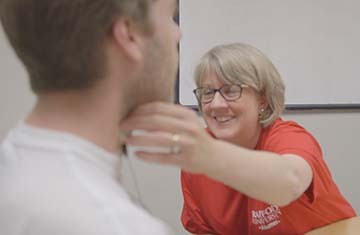Radford COSD students introduced to newest tool for swallowing therapy

To help patients recover from swallowing disorders, aspiring speech language pathologists (SLP) in the Radford University Department of Communication Sciences and Disorders (COSD) now have access to the latest therapy technology.
On April 27, COSD Instructors Terri Shelor and Diane Shepherd, M.S. ‘10, introduced first-year graduate students to the latest editions of Vital Stim. The Vital Stim, in which both Shelor and Shepherd are certified, enables SLP’s to help patients with muscle education and development of throat muscle use patterns.
“This is one more bridge between classroom and practice,” said COSD Chair Diane Millar. “Our students now have one more experience here similar to those they will encounter in their futures. We are grateful that the university was willing to invest in us, so we can invest in these future practitioners.”
The two units, a $5,000 investment, represent the standard of care in swallowing therapy, according to Shelor.
Shelor said the units are used in hospitals, skilled nursing centers and home health care settings by SLP’s who are certified in Vital Stim technology and protocols. Patients recovering from head and neck cancer, stroke, Parkinson’s Disease, dementia and traumatic brain injury are among those who might struggle with the often overlooked, yet vital, act of swallowing and would be re-learning the skill.
Radford COSD graduate students work with Vital Stim, a therapy tool that enables SLP’s to help patients with muscle education and development of throat muscle use patterns.
“Vital Stim is complementary,” said Shelor. “After assessment, we can use this along with other strategies and treatments to improve the quality of care we provide to those who are struggling to recover a very complicated and important process.”
For about 15 COSD graduate students who had just completed their semester-long course on dysphagia, or swallowing disorders, experiencing the new Vital Stim units was valuable.
“Access to emerging technology like this will better prepare me in best practices. I will see a little bit of everything and a wide variety of disorders next year as I go out into clinical settings,” said Cody Huber of Franklinton, North Carolina. “By wearing the unit and learning how to use it, I experienced it today from both the patient and practitioners’ points of view.”
The Vital Stim uses neuromuscular electrical stimulation to stimulate the muscles in the throat and is similar to tools used by other disciplines such as physical therapy when working with damaged muscles.
Huber described the sensation: “I felt a tingling in the muscles, like what I feel in the gym when I tense up the muscles while working out. The painful part was removing the electrodes from my beard.”